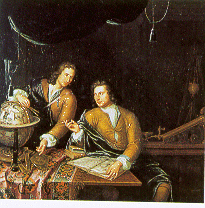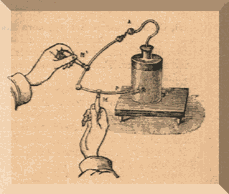 | ||
| Biographical notes | ||
| Chronology | ||
| Scientists index | ||
| Bibliography | ||
|
| |
|||
 |
Pieter van Musschenbroek |  | |
(Leiden
Netherlands 14.March.1692 - Leiden
19.September.1761 ) | |||
| | H.van der
Mij- Jan
e Pieter van Musschenbroek -Leida Museum Boerhaave. The siblings researchers represented with i they scientific instruments. |
1745
Condenser
|
|
| |
||
|
| Physicist, to
which the merit of the invention of the “bottle of Leyda”
is given, Leyda is the locality where worked exactly Musschenbroek. The
invention has happened independently from the invention of Kleist
In 1746
wrote to Réamour to have had a experience with a
“jolt”, be a matter of
electric discharge to high upgrades them, lacks ulterior documentations. |
|
| |
||
Bottle of Leida |
||
Condenser
electrical worker of classic form, constituted from a bottle of glass
back wide, whose inside is covered from a metallic armor on the bottom
and the walls (excluded the forming throttling the neck), connected
with a finished metallic stem from a little ball, while the
external part is covered from a second metallic armor, till the height
of that inner one. The sheets can be made of tinfoil, and in
such
case cannot be removed because breaker
or at least they
would be become deformed, making to vary the
characteristics of the
apparatus; or of a metallic sheet of sufficient thickness, for being
able to remove it and to introduce in place without to
alter the
form and
therefore the characteristics
of the  apparatus. The
operation of condenser is based
on the principle that the
electric charges of contrary sign is gained and
they make
equilibrium; therefore, placing the little ball of the stem to
contact with a electrostatic machine that
holding in hand the
bottle, so that the external armor is to
earth, the inner armor
charge of electricity of a sign and that external of contrary
sign,
that they make mutual equilibrium. If now, for means of an arc
arrester, we put to contact the two armors, an electric discharge is
had, whose intensity depends from the surface of the armors and the
dielectric constant of the interposed insulator. It can be demonstrated with the Bottle of Leida demountable that the electric charges are not on the armors, but on the two faces of the dielectric, in this case on the glass: in facts removing the armors and putting them to contact, that the door to the same one upgrades them, and then replacing them to place in the bottle, the discharge is had equally, because the electrical shock of contrary sign, gaining itself, they stretch to approach itself most possible, and therefore to prepare on the two faces of the dielectric, which does not allow a greater approach. The metallic armors do not have therefore other function that that of to allow to the electric charges of to distribute itself on the surface of the dielectric with which they are to contact. | ||

